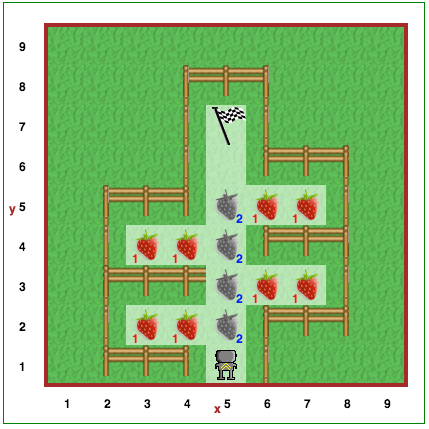Step 5: Defining New Functions¶
CS20-CP1 Apply various problem-solving strategies to solve programming problems throughout Computer Science 20.
CS20-CP2 Use common coding techniques to enhance code elegance and troubleshoot errors throughout Computer Science 20.
CS20-FP3 Construct and utilize functions to create reusable pieces of code.
Tutorial¶
After completing the last step, you have realized that having Reeborg make
three left turns in a row gives the same final result as if it were to
make a single right turn. It was probably becoming quite
tedious to have to write three turn_left() instructions each time
you want to have Reeborg turn right. Wouldn’t it be nicer if you could
simply write turn_right()?
Just as we can call built-in functions like turn_left() and move(), we can create our own functions as well. We can define a new Python function as follows:
def turn_right():
turn_left()
turn_left()
turn_left()
That’s it! You will now be able to avoid having to write three
turn_left() functions in a row to simulate a right turn!
How to think about def¶
You have just seen how to define a function in Python. Chances are, you understood right away how to think about them but, just in case, here’s a more detailed explanation which will help you to not only understand how functions work, but also other Python constructs that involve blocks of code.
Suppose we have the following:
def turn_right():
turn_left()
turn_left()
turn_left()
move()
turn_right()
move()
This is equivalent to the following:
def turn_right():
turn_left()
turn_left()
turn_left()
move()
turn_left()
turn_left()
turn_left()
move()
In other words, def defines a name like turn_right that we can use as a shortcut
for all the code that appears inside the code block, and whenever we see
the shortcut being called like turn_right(), we can think of it as being equivalent to inserting the code block at that location.
Your Turn¶
Open Step 5 on the Reeborg environment.

Reeborg wants to pick some strawberries in its garden. Reeborg’s garden has a very strange shape, as you’ve seen above. Define a pick_two_berries() function that picks up two strawberries and puts them on the ground. Use it four times as part of your solution. As always, be sure to use comments and whitespace to increase the readability of your solution!